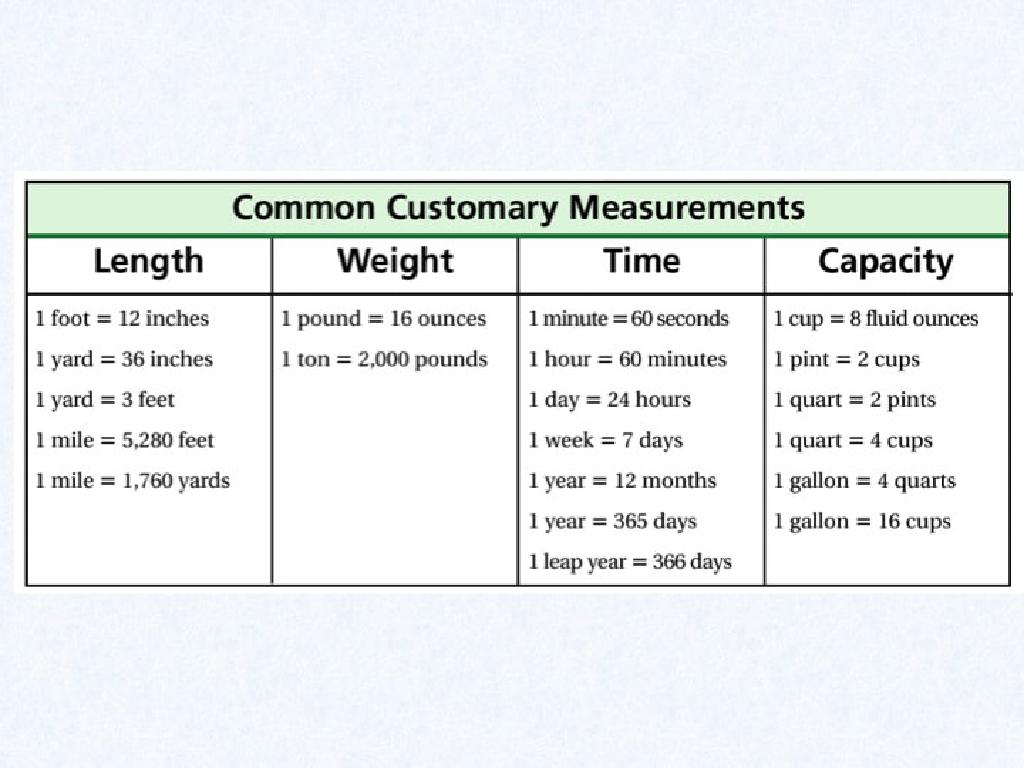Formatting Street Addresses
Subject: Language arts
Grade: Sixth grade
Topic: Formatting
Please LOG IN to download the presentation. Access is available to registered users only.
View More Content
The Basics of Formatting Street Addresses
– Understanding Formatting
– Formatting means arranging text clearly and consistently.
– The Importance of Formatting
– Proper formatting helps convey information effectively.
– Today’s Lesson: Street Addresses
– Learn how to write addresses neatly and properly.
– How to Format Addresses Correctly
– We’ll cover the order of elements and punctuation.
|
This slide introduces the concept of formatting in written communication, emphasizing its importance in ensuring clarity and consistency. Formatting is crucial for making information easily accessible and understandable. Today’s focus is on formatting street addresses, a practical skill that students will use in their personal and, eventually, professional lives. The lesson will cover the standard order of address elements, such as the recipient’s name, street number, street name, city, state, and zip code, as well as the use of commas and periods. Encourage students to think about the last time they wrote an address and whether they considered how it was formatted.
Understanding Street Addresses
– Components of a street address
– Number, street, city, state, zip code
– Sample street addresses
– 123 Maple St., Springfield, IL 62704
– Common address abbreviations
– St. for Street, Rd. for Road, Ave. for Avenue
|
This slide introduces students to the structure and formatting of street addresses. Begin by explaining the components of a street address, which typically include the house or building number, street name, city, state, and ZIP code. Provide clear examples of formatted addresses to illustrate these components. Discuss common abbreviations such as St. for Street, Rd. for Road, and Ave. for Avenue, and explain why these abbreviations are used. Encourage students to look at envelopes at home for real-life examples of formatted addresses. This will help them understand how to properly write and recognize addresses in their daily lives.
Formatting Street Addresses
– Order of address elements
– Start with recipient’s name, street, city, state, zip code
– Commas and periods usage
– Commas separate elements, periods after abbreviations
– Capitalization rules
– Capitalize proper nouns and first letters
– Understanding line breaks
– Each part of the address begins on a new line
|
This slide introduces students to the standard format for writing street addresses. Emphasize the importance of placing each element in the correct order for clarity and proper delivery. Discuss the use of commas to separate address components and periods for abbreviations like ‘Ave.’ for Avenue. Highlight the need for capitalization of proper nouns and the first letter of each address line. Explain that line breaks are crucial for separating each part of the address, making it easy to read. Provide examples of properly formatted addresses and have students practice by writing addresses from familiar places or creating their own.
Practice: Formatting Street Addresses
– Format a simple address
– Example: 123 Maple St, Springfield, IL 62704
– Address with an apartment number
– Example: 456 Oak St, Apt 101, Springfield, IL 62704
– Discuss address format importance
– Correct format ensures accurate delivery and clear communication.
|
This slide is designed to provide students with practical examples of how to properly format street addresses, both simple and those including apartment numbers. Start with a simple address format, highlighting the order of street number, street name, city, state, and ZIP code. Then, show how an apartment number is incorporated into the format. Emphasize the importance of correct formatting to ensure mail and packages are delivered to the right location and to avoid confusion. Encourage students to practice writing addresses and to understand how this skill is essential for clear communication in everyday life.
Class Activity: Address Formatting Relay
– Write an address on the board
– Classmates suggest corrections
– Discuss why changes are needed
– Why is the correct format important?
– Learn proper address formatting
– Understand elements like street, city, state, and ZIP code
|
This interactive activity is designed to engage students in learning the proper format of street addresses. Each student will have the opportunity to write an address on the board, and then the class will collaboratively identify any mistakes and suggest improvements. This will help students understand common errors and the importance of correct address formatting. The teacher should guide the discussion on why certain changes are made, emphasizing the elements of a properly formatted address. Possible variations of the activity could include using fictional addresses, addressing envelopes for a class project, or correcting deliberately flawed addresses provided by the teacher.
Conclusion: Mastering Address Formatting
– Recap address formatting rules
– Understand practice significance
– Homework: Collect 3 addresses
– Find addresses from mail, books, or online
– Share findings next class
– Be ready to explain the format used
|
This slide wraps up the lesson on formatting street addresses by summarizing the key rules and emphasizing the importance of practice for mastery. For homework, students are tasked with finding three examples of properly formatted addresses from various sources such as mail, books, or online. This exercise will help reinforce their understanding of the standard address format. In the next class, students will share their findings and discuss the components of each address, such as the recipient’s name, street number, street name, city, state, and ZIP code. Encourage students to explain the format used and why it’s important to write addresses correctly, such as ensuring mail delivery accuracy.






